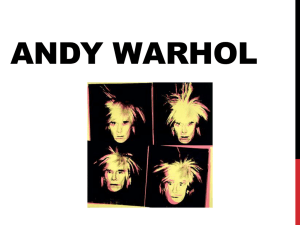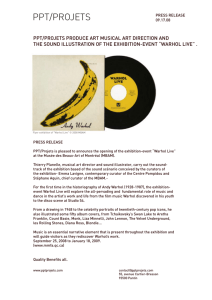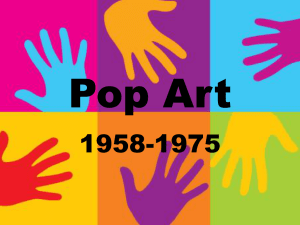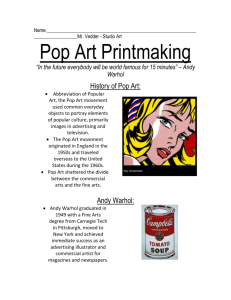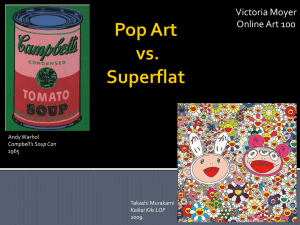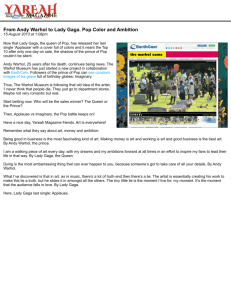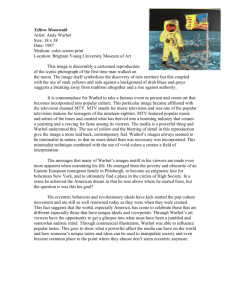Warhol - Moorestown Home and School Association
advertisement
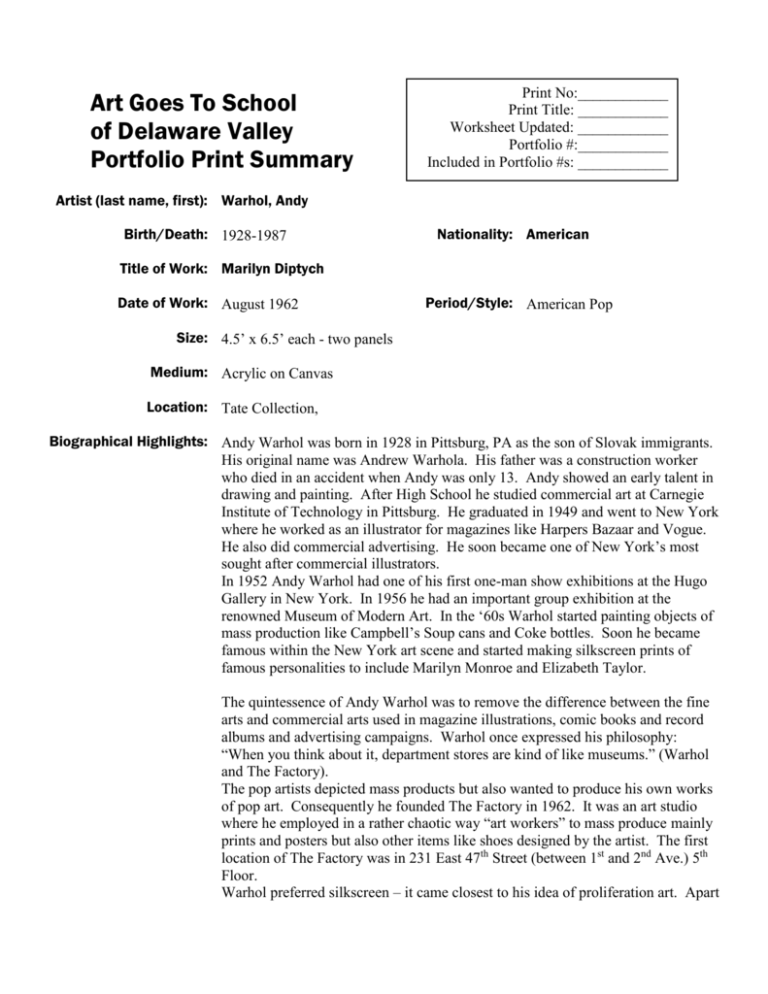
Art Goes To School of Delaware Valley Portfolio Print Summary Print No:____________ Print Title: ____________ Worksheet Updated: ____________ Portfolio #:____________ Included in Portfolio #s: ____________ Artist (last name, first): Warhol, Andy Birth/Death: 1928-1987 Nationality: American Title of Work: Marilyn Diptych Date of Work: August 1962 Period/Style: American Pop Size: 4.5’ x 6.5’ each - two panels Medium: Acrylic on Canvas Location: Tate Collection, Biographical Highlights: Andy Warhol was born in 1928 in Pittsburg, PA as the son of Slovak immigrants. His original name was Andrew Warhola. His father was a construction worker who died in an accident when Andy was only 13. Andy showed an early talent in drawing and painting. After High School he studied commercial art at Carnegie Institute of Technology in Pittsburg. He graduated in 1949 and went to New York where he worked as an illustrator for magazines like Harpers Bazaar and Vogue. He also did commercial advertising. He soon became one of New York’s most sought after commercial illustrators. In 1952 Andy Warhol had one of his first one-man show exhibitions at the Hugo Gallery in New York. In 1956 he had an important group exhibition at the renowned Museum of Modern Art. In the ‘60s Warhol started painting objects of mass production like Campbell’s Soup cans and Coke bottles. Soon he became famous within the New York art scene and started making silkscreen prints of famous personalities to include Marilyn Monroe and Elizabeth Taylor. The quintessence of Andy Warhol was to remove the difference between the fine arts and commercial arts used in magazine illustrations, comic books and record albums and advertising campaigns. Warhol once expressed his philosophy: “When you think about it, department stores are kind of like museums.” (Warhol and The Factory). The pop artists depicted mass products but also wanted to produce his own works of pop art. Consequently he founded The Factory in 1962. It was an art studio where he employed in a rather chaotic way “art workers” to mass produce mainly prints and posters but also other items like shoes designed by the artist. The first location of The Factory was in 231 East 47th Street (between 1st and 2nd Ave.) 5th Floor. Warhol preferred silkscreen – it came closest to his idea of proliferation art. Apart from being an art producing machine, The Factory served as a film-making studio. Warhol made over 300 experimental underground films – most bizarre and some pornographic. His first one was called Sleep and showed nothing but a man sleeping for over 6 hours. In July of 1968 Warhol was shot in the chest by a woman named Valerie Solanis. Warhol was seriously wounded however, narrowly escaped death. Solanis had founded a group named SCUM (Society for Cutting Up Men) and she was its sole member. When Solanis was arrested her words were “He had too much control over my life.” Warhol never fully physically recovered from this assassination attempt. At this point his artwork took a radical turn and he spent most of his time making individual portraits of the rich and affluent characters of his time like Mick Jagger, Michael Jackson and Brigitte Bardot. Warhol became more entrepreneurial and he began the magazine Interview and a night club. In 1974 The Factory moved to 800 Broadway and in 1975 Warhol published THE philosophy of Andy Warhol. In his book he describes art: “Making money is art, and working is art and good business is the best art.” Warhol had a very bizarre personality – he died his hair straw blond in the 50’s ad then replaced his real hair with blond and silver-grey wigs. The pop artist loved cats and images of cats can be found in many of his works. He was described by his friends as a work-aholic. However, he himself was obsessed by the ambition to become famous and wealthy. He knew he could only achieve that through hard work. In the few years before his death, Warhol supported and promoted artists like Keith Haring and Robert Mapplethorpe. Warhol died in 1987 following complications after a gall bladder operation. More than 200 attended his Memorial Mass at St. Patrick’s Cathedral. Little known fact - Warhol was a very religious man. In May 1994 the Andy Warhol Museum opened in his hometown of Pittsburg, PA. Other Works by Artist: Campbell’s Soup Cans (1962) – Green Coca Cola Bottles (1962), Shot Marilyns (1964), Exploding Plastic Inevitable (1966), Big Electric Chair (1967), Camouflage Self Portrait (9186) Interpretation: The Marilyn Diptych is a silk screen painting (1962). The work was completed in the weeks following Marilyn Monroe’s death in August 1962. It contains 50 images of the actress which were all based on a single publicity photograph from the film Niagara. The 25 pictures on the left side of the diptych are brightly colored, where the 25 on the right are in black and white and blurred and faded. The juxtaposition of the color v black & white pictures is sometimes thought to represent Monroe’s life and mortality. The black and white pictures can also be said to represent her career in film and magazines. The piece is currently on display in the Tate Liverpool. In 2004 it was named the third most influential piece of modern art in a survey of more than 500 artists and critics. Presentation Ideas: Have the children make their own “iconic” art. Use a single photograph repeated over and over in black and white. Have the children make them into a collage and hand color some photos while leaving others black and white. Compare and contrast: Compare with other more traditional portraits. What does the repetition do to the image? What do you see by looking at multiple images? What does color v. black and white illuminate? Selected References:

